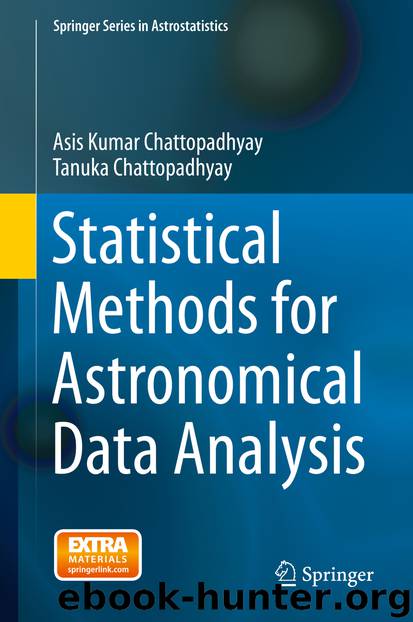Statistical Methods for Astronomical Data Analysis by Asis Kumar Chattopadhyay & Tanuka Chattopadhyay

Author:Asis Kumar Chattopadhyay & Tanuka Chattopadhyay
Language: eng
Format: epub
Publisher: Springer New York, New York, NY
7.3.2 Approximation of Negentropy
One drawback of negentropy is that it is very difficult to compute. That’s why it needs to be approximated (Hyvarinen et al. 2001). The approximation is given by:
(7.14)
where G is a non-quadratic function. In particular, G should be so chosen that it does not grow too fast. Two popular choices of G are:
(7.15)
where 1 ≤ a ≤ 2 is some suitable constant, which is often taken equal to 1.
7.3.3 The FastICA Algorithm
There are many algorithms which do ICA like FastICA, ProDen (Hastie and Tibshirani 2003), KernelICA, etc. The fastICA algorithm is a commonly used one, including industrial applications. This algorithm was developed by Hyvarinen and Oja (2000). In this method the independent components are estimated one by one. This algorithm converges very fast and is very reliable. This algorithm is also very easy to use. Our objective is to maximize J(S). Now this is equivalent to maximizing E[G(WZ)] as given in Eq. (7.13) under the constraint | | W | | = 1. For the sake of notational and computational complicity, we consider one particular component. We are interested in finding out the optima of E[G(W K T Z)] under the constraint | | W | | = 1, where W K T Z is the kth component of WZ. This optimization problem can be solved by the Lagrange multiplier method. The objective function is
Download
This site does not store any files on its server. We only index and link to content provided by other sites. Please contact the content providers to delete copyright contents if any and email us, we'll remove relevant links or contents immediately.
Tools of Titans by Timothy Ferriss(7815)
Turbulence by E. J. Noyes(7701)
Astrophysics for People in a Hurry by Neil DeGrasse Tyson(5002)
Secrets of Antigravity Propulsion: Tesla, UFOs, and Classified Aerospace Technology by Ph.D. Paul A. Laviolette(4992)
Design of Trajectory Optimization Approach for Space Maneuver Vehicle Skip Entry Problems by Runqi Chai & Al Savvaris & Antonios Tsourdos & Senchun Chai(4843)
Room 212 by Kate Stewart(4739)
Pale Blue Dot by Carl Sagan(4618)
The David Icke Guide to the Global Conspiracy (and how to end it) by David Icke(4381)
A Journey Through Divination and Astronomy by Publishing Pottermore(4250)
Apollo 8 by Jeffrey Kluger(3512)
Goodbye Paradise(3446)
Losing the Nobel Prize by Brian Keating(3425)
COSMOS by Carl Sagan(3348)
The Five People You Meet in Heaven by Mitch Albom(3335)
How to Read Water: Clues and Patterns from Puddles to the Sea (Natural Navigation) by Tristan Gooley(3240)
Brief Answers to the Big Questions by Stephen Hawking(3239)
How to Read Nature by Tristan Gooley(3079)
The Order of Time by Carlo Rovelli(3073)
A Brief History of Time by Stephen Hawking(2819)
